20+ Employee Engagement Ideas for Your Growing Business
Engaged employees are more productive, loyal, and likely to speak positively about your business to friends and family. Outside of a few highly motivated individuals, your engagement levels depend on your business and your practices for connecting with employees.
Of course, it’s easy to want to engage your employees and another thing to brainstorm engagement ideas, put them into action, and ensure they have long-term results. To help your business overcome this first obstacle, we’ll dive into over 20 employee engagement ideas that can transform your business.
Let’s jump in!
1. Create an employee giving program.
Employees feel engaged when their work is meaningful and they know their employer shares their values. Demonstrate to your employees that you care about creating a positive impact and get them involved in making an impact by launching an employee giving program.
Employee giving programs are charitable programs run by businesses to collect and distribute donations to nonprofit organizations. There are several variations on this basic program businesses can try, such as:
- Matching gifts. Let employees support the specific organizations they care about and motivate them to give more through matching gifts. Matching gifts are a popular type of workplace giving wherein the business matches employees’ donations, usually at a dollar-per-dollar rate, to eligible nonprofits. Which nonprofits are eligible for a matching gift is up to you, though most businesses allow gifts to all nonprofits, except for organizations that are religious, political, or owned by the employee or their family.
- Payroll deductions. Remove the cognitive workload of researching nonprofits, filling out forms, and remembering to continue giving with payroll deductions. Have employees sign up for payroll deductions when they join your business or at the start of your financial year. From then on, a portion of their paycheck will be automatically donated to a nonprofit of their choosing.
- Donation credits. Rather than asking employees to donate part of their paychecks, businesses can gift employees funds specifically earmarked for donating. You might give employees a set amount of donation credits for the year or award them for accomplishments.
If you’re not sure what type of employee giving program will best engage your team, just ask them! Send out a survey asking employees if they’re interested in giving back through their work and how they would like to make an impact.
2. Encourage peer-to-peer appreciation.
Recognition in the workplace lets employees know their efforts are impactful and provides positive feedback for what they should do in the future. However, your leadership can’t see everything employees do, meaning great performances often go unrecognized.
Engage employees by expanding your appreciation efforts through a peer-to-peer recognition strategy. Rather than just leadership acknowledging employees, colleagues can shout out each other when they do a good job, creating a culture of appreciation and helping your staff bond with one another.
A few approaches for peer-to-peer recognition include digital eCards employees can send each other, a public bulletin or whiteboard employees can add messages to, or quick messages employees can submit to have read at team and all-hands meetings.
Digital options are ideal for hybrid and remote teams. Our remote employee recognition guide shares a great example from Voxpopme. This company has a Slack channel called #boom, where employees call out peers’ successes publicly.
3. Be transparent.
A staggering 87% of job candidates want their future employers to be transparent. Transparency is in high demand because it provides employees with must-have benefits for their careers, like:
- Professional and industry insight
- The ability to plan for the future and adapt their skills
- Knowledge about why and how decisions are made
Transparent businesses often have increased employee buy-in for new projects and strategies since their teams understand leadership’s goals and the company’s directions. When employees have greater buy-in, they tend to be more engaged.
This also leads to a higher trust environment where employees feel more comfortable sharing their concerns and ideas. Plus, when employees know what’s happening at the business across multiple teams, their ideas tend to be more intersectional and beneficial for the company as a whole.
4. Design an employee experience program.
You may have heard of customer experience programs in the past, which are essentially systems a business uses to collect and act on feedback to improve consumer relationships. Businesses can implement this same strategy to build stronger connections with employees, leading to higher engagement.
Qualtics, essentially the provider of all types of experience programs, defines employee experience as the following:
From the moment prospective employees look at your job opening, to the moment they leave your company, everything that the workers learn, do, see, and feel contributes to their employee experience. For your organization to master employee experience management, you must listen to your people at each stage of the employee lifecycle, identify what matters most to them, and create personalized, bespoke experiences.
To summarize, employee experience consists of every interaction employees have with your business from hiring to exit interviews. Employee experience programs boost employee satisfaction—and subsequently loyalty, engagement, and productivity—by organizing these interactions into a quantifiable “employee journey.”
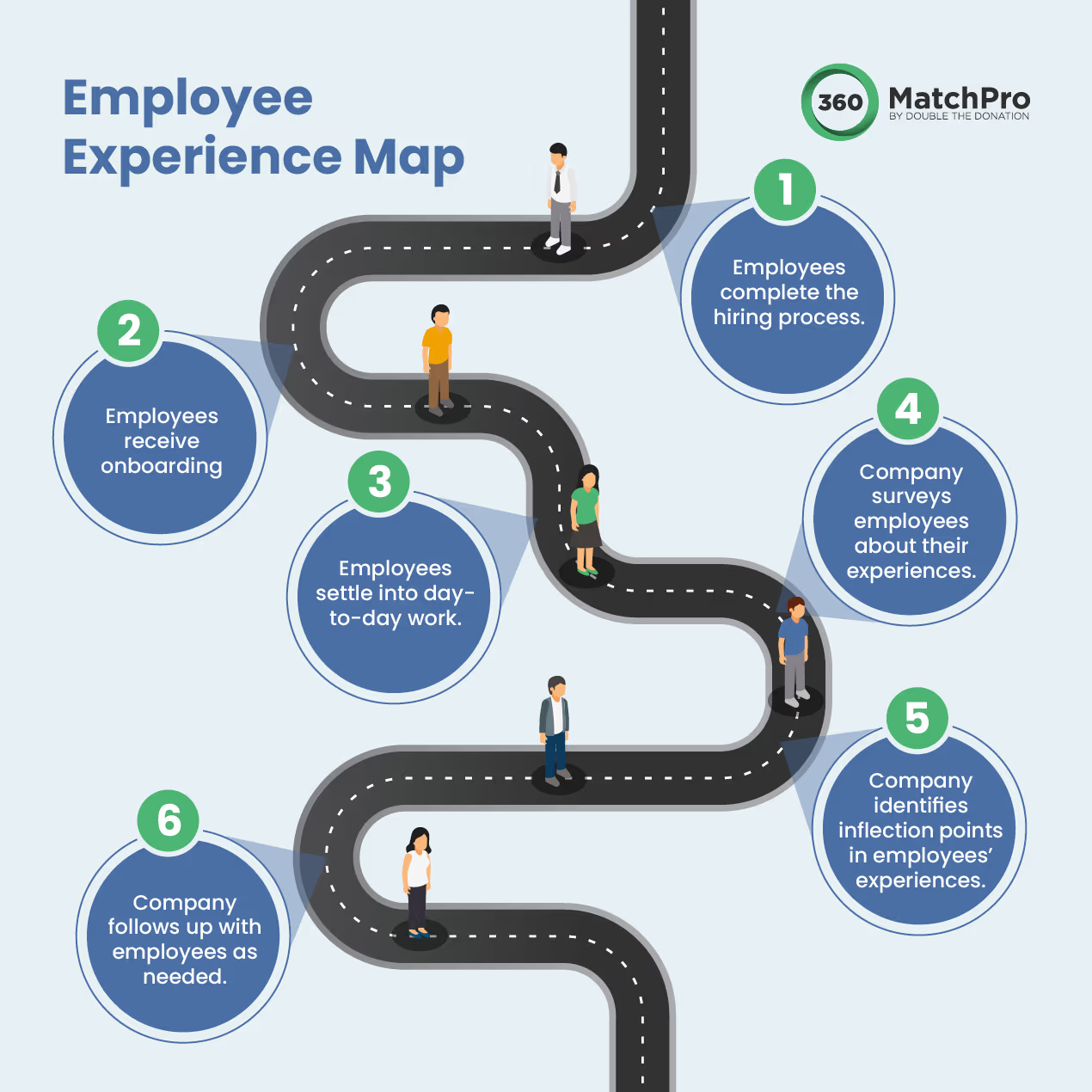
The employee journey charts the general trajectory employees take in their day-to-day work, whether they’re answering emails, interfacing with customers, or designing new products. Employee experience programs revolve around sending employees surveys to ask about these daily experiences, what parts of their job make them feel fulfilled, and what frustrates them.
When an employee shares something that frustrates them in a survey, forward their response to the appropriate party—usually their manager, though sometimes technical support or HR—to resolve the issue. Remember, the focus should be on responding to surveys and specific complaints, not just collecting data.
5. Host employee volunteer days.
Workplace giving programs allow employees to give back to their communities, and you can engage employees further by encouraging them to take an even more hands-on approach through employee volunteer days.
Employee volunteer days are a form of corporate volunteerism in which your business organizes volunteering opportunities with nonprofit organizations. Generally, the process for setting up a volunteer day looks something like this:
- Choose a nonprofit to work with. Consider what causes your employees would want to volunteer for, what your team can provide the nonprofit, and whether the nonprofit has volunteer opportunities that will accommodate your entire team. Be conscious of when and where the volunteer opportunity is to ensure as many employees can participate as possible.
- Contact the nonprofit in advance. Get in touch with your chosen nonprofit far in advance to discuss your volunteer day. Share approximately how many people you expect to attend and what types of activities you would do. Be flexible, as nonprofits may need help planning for a large group on short notice. For instance, you may be asked if it’s okay to split your team into smaller groups, rather than all working together as one large unit.
- Put a date on the calendar. Let employees know when and where the volunteer opportunity will take place. Request RSVPs so you can get an accurate headcount for who is coming. Then, communicate this number to your contact at the nonprofit.
When planning a volunteer day, remember that the more organized and structured the event is, the better an experience it will be for your team and the nonprofit.
6. Allow for creativity.
Your employees have on-the-ground knowledge about your business from their day-to-day work. As such, they probably also have ideas to improve operations. Encourage them to share their insights and, when possible, provide them breathing room to get creative. By giving them creative freedom, you’ll give employees ownership over their work, heightening their investment in it.
Depending on your business model, you may even consider providing employees with a certain number of “free” hours during the work week to allocate to any project or activity of their choosing. Employees can use this time to flesh out innovative new ideas, find creative solutions to current problems, or simply work on tasks they need more time to accomplish.
7. Create office awards.
Appreciation is always appreciated, whether it’s official recognition for major accomplishments or an informal or even slightly silly shout-out for being a positive presence in the office.
Take your appreciation strategy further by giving employees office awards to aim for like:
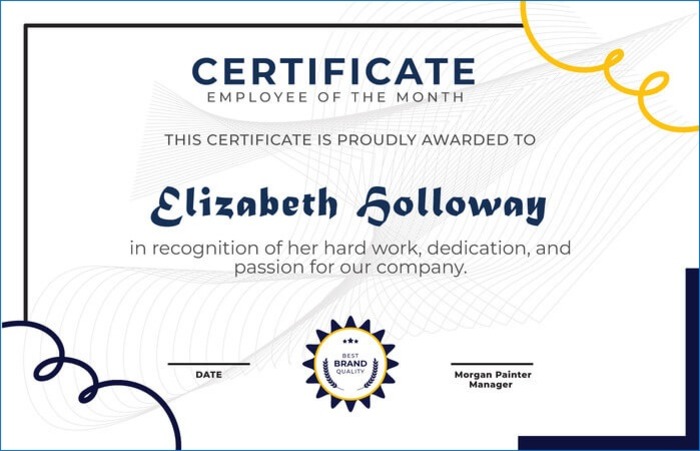
- Rookie of the Year
- Most Improved
- Outstanding Mentor
- Office Culture Ambassador
- Community Impact Award
When implementing office awards, be clear to employees about their purpose. Are these serious awards that come with bonuses? Should employees get competitive over them? Or are these meant to be a casual celebration of your team they shouldn’t take too seriously?
8. Build career development pathways.
Engagement increases when employees know their hard work will be rewarded with career advancement and new opportunities. Set clear guidelines for how employees can move up the ladder at your business and what they can do to speed up the process.
For instance, you might:
- Offer extra skill training and development opportunities.
- Provide opportunities to work on new projects outside employees’ normal duties.
- Hold one-on-one conversations with ambitious employees about how they can expand their roles.

When it comes to career development, ensure employees understand their end goal. Taking on new responsibilities should be seen as an exciting stepping stone to advancement, and employees’ job descriptions and compensation should be adjusted accordingly. Otherwise, while changing up daily tasks may keep things interesting, receiving more work for the same pay is likely just to burn out employees.
9. Be open to employee feedback.
Communication at your business should be a two-way street. Leadership provides direction for employees and evaluates their performance, and employees share whether instructions were clear, adequate resources were provided, and if they felt supported to complete their jobs successfully.
When gathering feedback, ensure you have questions that allow employees to elaborate on their specific experiences while also focusing on the parts of your business you feel you need their insight about.
From there, the two main methods for gathering employee feedback are:
- Individual conversations. Have employees meet with their managers to answer your questions. A one-on-one conversation allows employees to go into detail about their thoughts, and managers can ask questions if something is unclear or an unexpected answer comes up.
- Anonymized surveys. Send out anonymous surveys for employees to fill out by a specific deadline. By virtue of being anonymous, you won’t be able to follow up with responses or ask questions easily, but you can guarantee you’ll receive honest feedback.
Asking for and implementing employee feedback creates a positive engagement loop. Employees will feel listened to and like their ideas matter, increasing their engagement. Then, because they are engaged, they’ll feel more invested in sharing their ideas and experiences to make your business a better place.
10. Provide a flexible work environment.
In a 2022 survey about employment in the U.S., job seekers cited a flexible workplace as one of their top three priorities for finding a new job. The interesting part is that “flexible” is not just code for remote work. Instead, the study found that employees of all age groups, professions, and education levels have a shared desire to have at least some flexibility about when they do and do not come into the office.
Consider your business model and where you have space for flexibility. Do some teams have the ability to work entirely from home? Would one day a week in the office help productivity? Do employees or leadership choose this day?

When rolling out any new work model, ensure your work expectations are clear before employees change their work environments. For example, you might allow employees to work four days a week from home but ask them to be available for email communication and impromptu meetings as needed.
11. Encourage a healthy work-life balance.
Even the most engaged employees can become unengaged if they fall victim to burnout. Burnout happens for a number of reasons, but one of the most common, especially in the age of hybrid work, is an unhealthy work-life balance.
While flexible work environments are in demand, they come with a few caveats businesses should be aware of when implementing a hybrid model. For instance, working from home can blur the line between “work” and “home,” resulting in employees feeling pressured to answer emails and work on projects even when they are no longer on the clock.
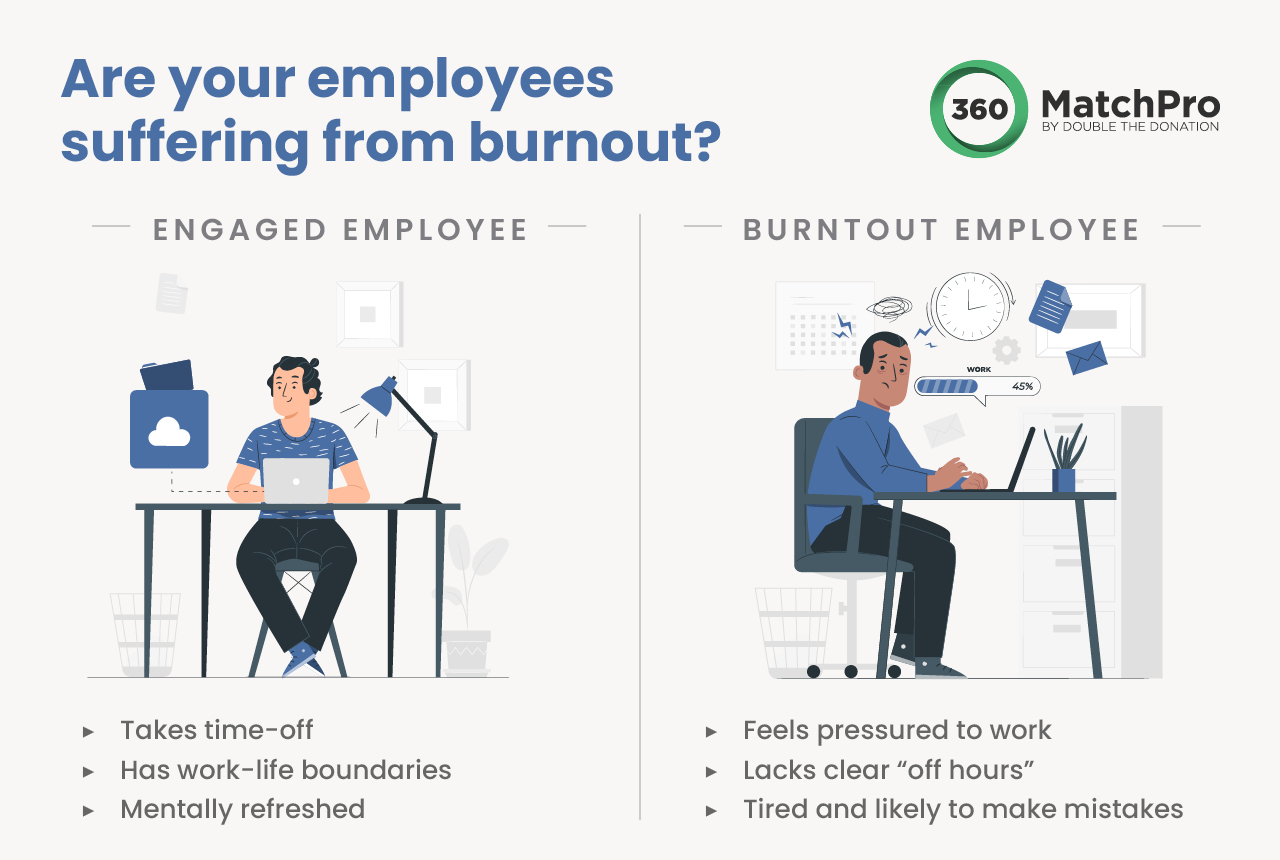
Help your employees recover from burnout by providing resources and advice about maintaining boundaries between work and off time. This includes tips like making a dedicated workspace, being cautious about reallocating hours, and using their allocated PTO.
For a real-world example, take inspiration from Adobe’s Wellness reimbursement and Emotional wellbeing programs. These programs provide Adobe employees with an annual budget, paid for by Adobe, to spend on activities, services, and products that will improve their physical and mental well-being. By having the resources to take care of themselves in their off hours, Adobe knows their staff will be ready to work when they clock in.
12. Host work culture events.
Work time should be for work, but you can make those hours on the clock more productive by carving out space for employees to engage with one another more casually. Work culture events are the perfect opportunity for your employees to relax a little and get to know one another, building camaraderie and adding an extra perk to working for your business.
Work culture events can be big or small, including activities like:
- Free pizza lunch
- After work dinner
- A team walk through a nearby park
- An organized workshop employees take together
Take the burden of planning these activities off of leadership by letting employees submit their ideas for consideration and even organizing cultural events themselves. If you hand over the reins to employees, set a maximum budget for events.
13. Hire for fit.
All the engagement strategies in the world will only matter if you have a receptive team. During the hiring process, assess candidates not just on their skills and past work but how they will fit into your company culture.
Note that hiring for fit does not mean excluding individuals who come from different backgrounds or have different life experiences than the rest of your team. Instead, it means asking questions about how the candidate would respond to various scenarios likely to crop up at your workplace.
Would they be competitive or collaborative? Do they prefer to work independently, or are they a team player? Is their first instinct to ask for help, or do they prefer to problem-solve independently? The right answers to these questions depend on your unique workplace!
When employees are in an environment with work-related values that align with theirs, they’re more likely to participate in company activities, bond with their co-workers, and be invested in the success of your business.
14. Create a mentorship program.
New employees are excited and nervous to get started at your business, and you can make sure they feel engaged with their work from the very start by instituting a mentorship program. By partnering new employees with senior ones, hirees will get:
- Someone they can go to for help with questions that are confusing but may not be big enough to bring up to their manager.
- A friendly face among their new co-workers who can help them break the ice with the rest of the team.
- An additional source of support to turn to and advocate for them throughout the onboarding process.
Your current employees can also rekindle their engagement with your business by participating in a mentorship program. It’s an opportunity to step up and demonstrate their leadership skills, while also paying the support they received forward to create a positive work environment.
15. Use engagement software.
As you’ve already seen from this list, engagement programs can be simple and easy to implement or complex, long-running programs with several moving parts. To manage your strategies and ensure they produce results, turn to engagement software.
Employee engagement software refers to several different types of platforms, so know which engagement ideas you’re interested in before making any software purchases. As an overview, here are a few basic types of engagement software:
- Appreciation. Appreciation takes many forms, and you can make it convenient and systemized via software. Use an employee appreciation tool like an eCard platform for employees to create and send thank you cards to one another.
- Experience. We’ve already discussed employee experience programs. To keep these programs running, businesses need software solutions to create surveys, send them to target employees, aggregate the data, and elevate responses to the relevant parties.
- Corporate social responsibility (CSR). Use CSR software with a user-friendly employee portal to let your team report their volunteer hours, submit matching gift donation requests, and determine what nonprofits their payroll deductions go to.
At 360MatchPro, we know a thing or two about CSR software, and our advice is to look for a vendor that offers matching gift auto-submission functionality. When turned on, this feature enables your employees to have their matching gift applications completed for them whenever they donate to a nonprofit that uses 360MatchPro. This drastically speeds up the matching gift process, boosting your business’s matching gift program participation rates.
If you’re curious about matching gift auto-submission software and how it works, check out this video from our team:
16. Provide fair and transparent compensation.
Let’s be frank—at the end of the day, your employees come to work to earn a living. Discussing compensation can be awkward given the weight of the topic, but it’s your responsibility as an employer to be transparent and honest about it.
Providing competitive wages and benefits is in your business’s and employees’ best interests. Employees will feel taken care of and be able to focus wholly on work instead of worrying about scrambling to make ends meet. Meanwhile, your organization can retain talented employees who might otherwise be lured away by other businesses willing to pay more.
When discussing bonuses and compensation changes, be frank about why decisions were made and ready to answer employee questions. Have a member of HR ready to handle potentially sensitive concerns, and make sure all official decisions are well documented for future reference.
17. Connect your company values to employee recognition.
We’ve already discussed how appreciating employees leads to increased engagement, but there’s an extra step you can take to recognize employees and instill your company values at the same time.
When showing appreciation for an employee, be specific about what they did that you’re recognizing. By connecting their actions to your company’s values, you can demonstrate your business’s commitment to its principles and reinforce a work culture that aligns with them.
For instance, check out this appreciation eCard from Modivcare:
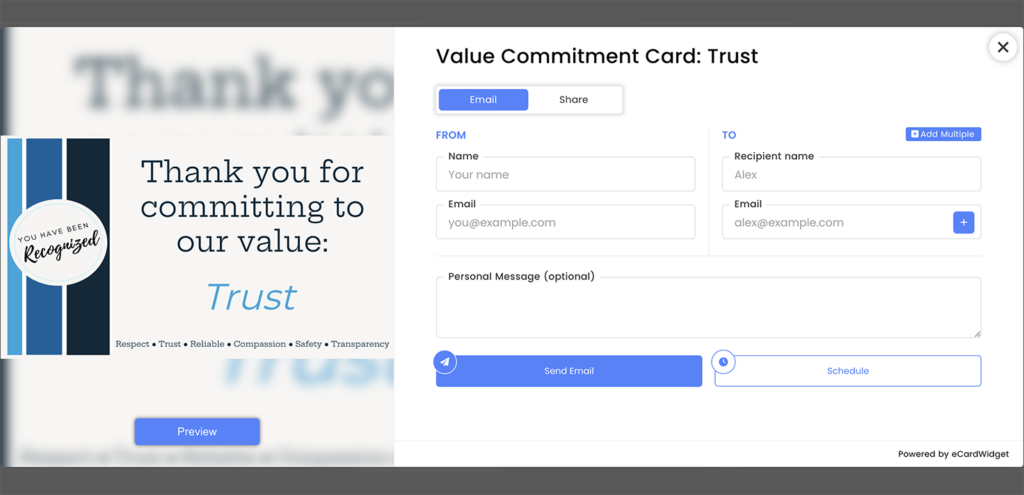
This eCard specifies the company value the employee is being honored for upholding, in this case, trust. There’s space for the card sender to explain how the employee demonstrated trust in their work. The eCard also has Modivcare’s other values listed on it, so all of its workplace principles are reinforced every time an employee is recognized.
18. Encourage autonomy.
What motivates your employees? Certainly getting a regular paycheck and reliable benefits goes a long way toward ensuring they show up every day, but research shows these external motivators only go so far in boosting engagement.
In 2000, psychologists Richard Ryan and Edward Deci published their theory of self-determination and intrinsic motivation. The study compares external and internal motivation, coming to the conclusion that:
Comparisons between people whose motivation is authentic (literally, self-authored or endorsed) and those who are merely externally controlled for an action typically reveal that the former, relative to the latter, have more interest, excitement, and confidence, which in turn is manifest both as enhanced performance, persistence, and creativity.
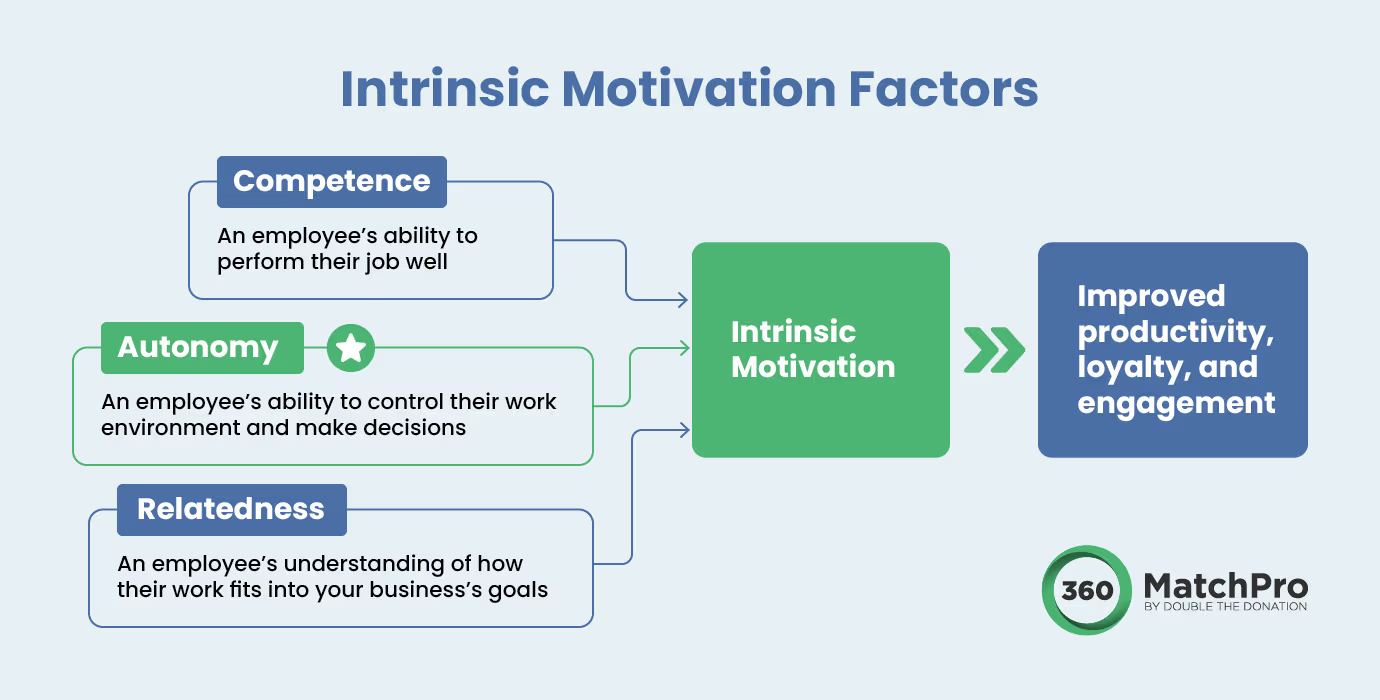
In other words, employees who are internally motivated to perform well will be more productive, creative, and dedicated, and they’ll produce better results. But how can you cause your employees to have intrinsic motivation?
Fortunately, the study also answers this, explaining that self-determination is influenced by competence (your employee’s ability to do a good job), relatedness (an understanding of why they’re performing their responsibilities), and autonomy. Of these, autonomy will likely require the most effort for your business to provide employees deliberately.
In addition to providing a flexible work environment, provide employees with freedom in managing their work. Encourage them even to try out ideas that are wholly their own and take ownership of their responsibilities.
19. Give out employee gifts.
Your employees already receive many benefits by working for your business, but you can add a few extra perks to brighten their days and keep them engaged. For special occasions such as work anniversaries and celebrations for successful projects, try giving out gifts like these:
- Branded company apparel
- Gift cards
- Snacks, such as pastries
- Office supplies
- Candles
These gifts can be small and casual, like giving everyone a branded thermos, or serious, like a certificate to attend an online professional development course. Feel free to give casual gifts, but for serious bonuses, be transparent with employees about what they can do to earn them so that all presents feel fair and earned.
20. Take complaints seriously.
Getting negative feedback or being alerted to a bad situation is never ideal, but when it occurs in the workplace, it’s your responsibility to treat it seriously. Whether employees have concerns about workplace conditions, co-workers, or work expectations, treat their formal complaints professionally and empathetically. By doing so, you’ll demonstrate your commitment to employee:
- Safety
- Satisfaction
- Comfort
- Inclusivity
When employees know they can trust leadership to resolve disputes and concerns, they’ll feel more engaged and loyal to their employer. Have a formal process for submitting complaints to ensure serious concerns can be quickly brought to your attention and addressed. If you currently struggle with this, consider conducting an HR audit.
21. Share your corporate social responsibility efforts.
Employees feel good about their workplaces when they know their employers are making a positive difference in the world. If your business conducts CSR initiatives, be proud and present your results to your employees.
You can promote your CSR efforts in multiple ways, such as sending out email updates to your team whenever something notable happens, creating an annual report to share with employees and customers, or making sure your program data is easily accessible for employees to check whenever they like.
For an example of how you can promote your CSR program, check out Amalgamated Bank’s website detailing all of the causes they have CSR initiatives for:
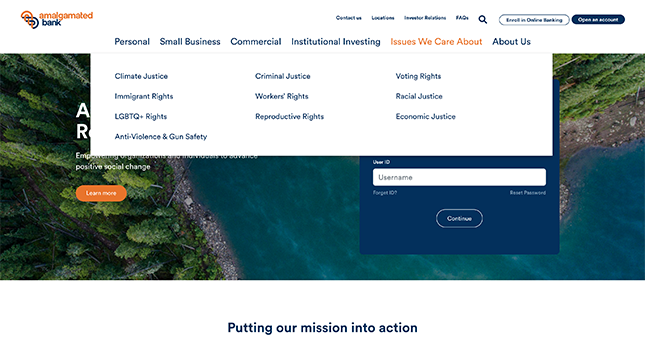
To ensure you can provide accurate, detailed updates about your CSR programs, carefully track data. Record how much you’ve decreased production emissions by, how much you’ve donated to nonprofits, how many volunteer days you organized, what you’ve done to improve your supply chain’s sustainability, and more.
Employee Engagement Ideas: More Resources
These ideas are just the beginning! Employee engagement looks different at every business because every organization’s team is different. Talk with your employees and consider the company culture you want to create to choose the engagement ideas that will work best for your team.
To discover even more ways to engage your employees, check out these resources:
- Employee Giving Guide: How to Empower & Engage Employees. Employee giving programs are one of the top ways to engage your team. Discover how this strategy works and explore steps for setting up a new giving program.
- Benefits of Workplace Giving: Why You Should Get Involved. Interested in starting a workplace giving program to engage employees? Get a deep dive into just how these programs help businesses.
- 11 Effective Employee Engagement Strategies for Businesses. Discover strategies for implementing engagement ideas like the ones in this guide and making your employee engagement program even more effective.






